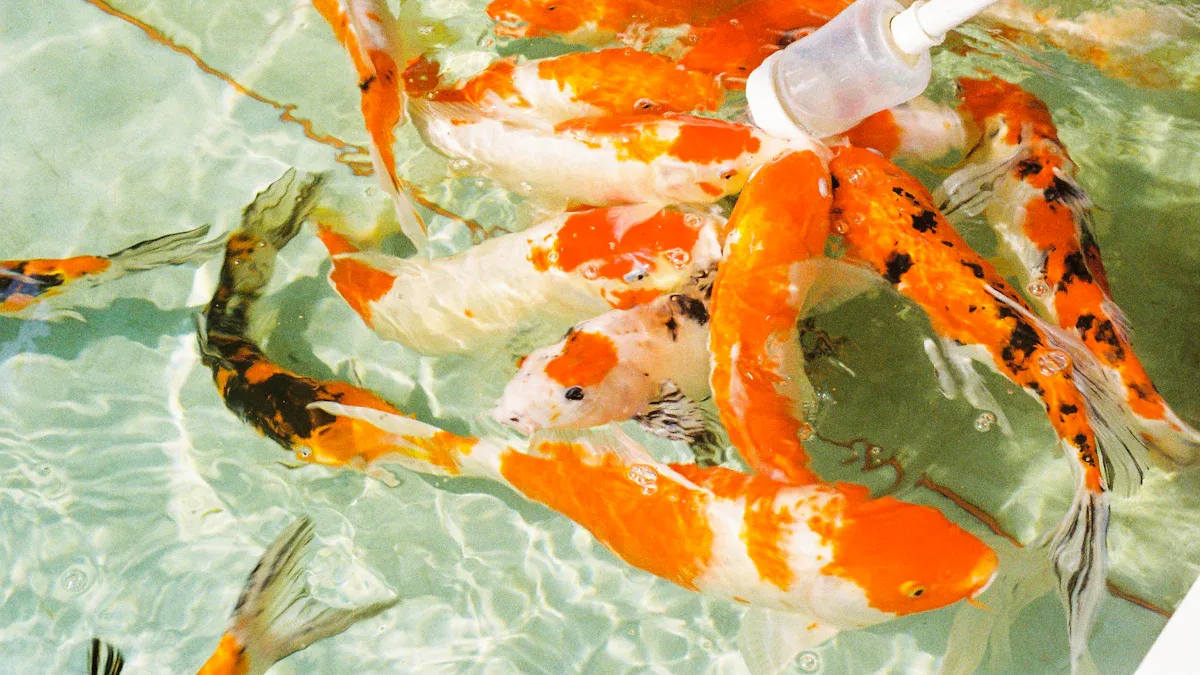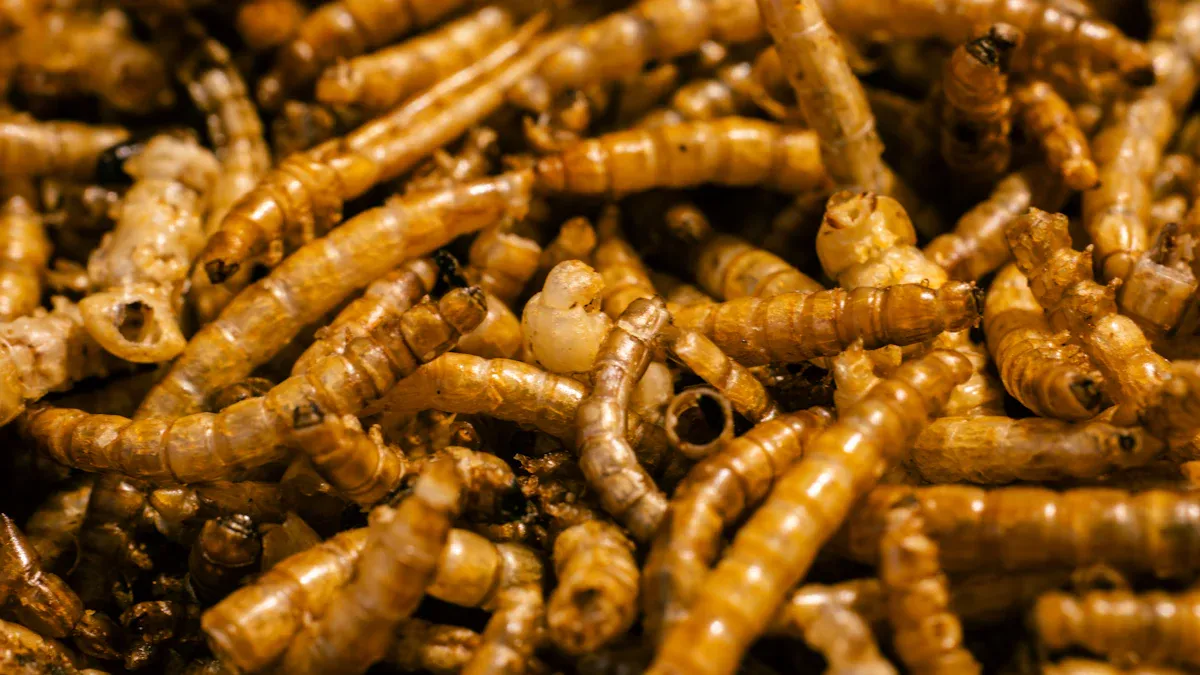
Dried mealworms for fish offer essential nutrients that support growth and overall health. These mealworms serve as a convenient and versatile food option, fitting seamlessly into any fish feeding routine. By incorporating dried mealworms, fish owners can enhance their pets’ vitality and promote robust immune responses, leading to healthier aquatic companions.
Key Takeaways
- Dried mealworms are rich in protein, containing up to 79%, which supports fish growth and muscle development.
- Incorporate dried mealworms into your fish’s diet once a week to enhance their health and vitality without overfeeding.
- Monitor your fish for any allergic reactions when introducing dried mealworms, and store them properly to maintain their quality.
Nutritional Benefits of Dried Mealworms for Fish
Dried mealworms for fish offer a wealth of nutritional benefits that can significantly enhance the health and vitality of aquatic pets. Understanding these benefits helps fish owners make informed decisions about their feeding routines.
High Protein Content
One of the standout features of dried mealworms is their impressive protein content. These mealworms can contain up to 79% protein, making them an excellent choice for supporting muscle development and overall growth in fish. Research shows that mealworm-based diets lead to significant growth improvements in species such as red hybrid tilapia and rainbow trout.
| Protein Content | Effect on Fish Growth |
|---|---|
| Up to 79% | Supports muscle development and overall growth |
| Mealworm-based diets | Significant growth improvements in red hybrid tilapia and rainbow trout |
This high protein level is crucial for young fish, as it aids in their rapid development and helps maintain the health of adult fish.
Essential Fatty Acids
Dried mealworms also provide essential fatty acids that are vital for fish health. These fatty acids include:
- Oleic acid (C18:1)
- Linoleic acid (C18:2)
- Linolenic acid (C18:3)
- Omega-3 fatty acids, which are beneficial for heart health and reducing inflammation.
These nutrients not only support energy levels but also contribute to a shiny appearance and vibrant coloration in fish. The presence of omega-3 fatty acids is particularly important, as they promote cardiovascular health and enhance the immune system.
Vitamins and Minerals
In addition to proteins and fatty acids, dried mealworms are rich in various vitamins and minerals that support overall fish health. They contain significant amounts of:
| Vitamin/Mineral | Comparison to Other Foods |
|---|---|
| Iron | Higher than eggs, pork, beef, lamb, fish, and milk |
| Copper | Present in significant amounts |
| Zinc | Present in significant amounts |
| Manganese | Present in significant amounts |
| Selenium | Present in significant amounts |
| Vitamin B1 | Substantial amount |
| Vitamin B2 | Significantly higher than other food sources |
| Vitamin E | 4.4 times that of pork, 3.2 times that of beef, 5.1 times that of lamb, and 10.6 times that of milk |
| Vitamin D | Substantial amount |
Additionally, dried mealworms provide essential minerals such as calcium, magnesium, and potassium, which are crucial for maintaining healthy bodily functions in fish. These nutrients help ensure that fish remain active, vibrant, and resilient against diseases.
Incorporating dried mealworms for fish into their diet can lead to improved growth, enhanced coloration, and overall better health. By understanding the nutritional benefits, fish owners can make informed choices that promote the well-being of their aquatic companions.
Practical Incorporation Methods for Dried Mealworms

Incorporating dried mealworms for fish into feeding routines can enhance the overall health of aquatic pets. Understanding effective methods for feeding these nutritious treats is essential for fish owners.
Feeding Techniques
Different fish types require specific feeding techniques for dried mealworms. For instance:
| Fish Type | Feeding Technique for Mealworms | Dietary Preference |
|---|---|---|
| Saltwater Fish | Can be fed occasionally, but not as a staple. | Not part of their natural diet; varied diet needed. |
| Freshwater Fish | Can be fed mealworms regularly as part of a varied diet. | Accepts mealworms along with other protein sources. |
Saltwater fish should primarily consume a varied diet that resembles their natural food sources. In contrast, freshwater fish, such as arowanas, can enjoy dried mealworms regularly.
Frequency of Feeding
Feeding frequency plays a crucial role in maintaining fish health. Experts recommend offering dried mealworms to aquarium fish once a week. For smaller fish, cutting the mealworms in half makes them easier to consume. This approach ensures that fish receive the benefits of dried mealworms without overindulging.
Combining with Other Foods
Combining dried mealworms with other types of fish food creates a balanced diet. This mixture supports overall vitality and enhances growth. Here are some effective combinations:
- Use dried mealworms as a supplement, not a replacement for regular fish food.
- Combine them with nutrient-rich pellets or flakes for a varied diet.
- Mixing dried mealworms with live foods can enhance nutritional balance.
By diversifying their diet, fish owners can boost immune function and promote healthier, more vibrant aquatic companions.
Potential Drawbacks of Dried Mealworms for Fish
While dried mealworms for fish offer numerous benefits, fish owners should also be aware of potential drawbacks. Understanding these issues can help ensure a balanced and healthy diet for aquatic pets.
Allergies and Sensitivities
Some fish may experience allergic reactions to dried mealworms. Symptoms can vary, and it’s essential for fish owners to recognize them early. Here are some common symptoms associated with allergic reactions:
| Symptom | Description |
|---|---|
| Asthma | Immediate-onset asthma reported in bait handlers after exposure to mealworms. |
| Rhinoconjunctivitis | Inflammation of the nasal mucous membranes and conjunctiva, often occurring in sensitized individuals. |
| Urticaria | Skin reactions such as hives, which can occur upon contact with mealworms. |
Fish owners should monitor their pets closely when introducing dried mealworms into their diet. If any of these symptoms appear, it may be wise to discontinue feeding them.
Overfeeding Risks
Overfeeding dried mealworms can lead to several health issues for fish. It is crucial to maintain a balanced diet and avoid excessive portions. Here are some risks associated with overfeeding:
- Improper digestion: Overfeeding leads to improper digestion as dry food expands in the stomach, causing stress and health issues.
- Fatty liver: Excessive feeding can cause fatty liver disease due to nutrient accumulation.
- Rotting of fin: Stress from overfeeding can lead to fin rot, a serious condition for fish.
- Pollution in water: Leftover food decomposes, increasing ammonia and nitrates, which are toxic to fish.
- Blooming of algae: High nutrient levels promote algae growth, affecting water quality.
- Lack of oxygen: Decomposition of uneaten food depletes oxygen, risking fish suffocation.
- Effect on pH level: Decomposition releases acids, lowering pH and harming fish and plants.
To prevent these issues, fish owners should feed dried mealworms in moderation and remove any uneaten food promptly.
Storage and Shelf Life
Proper storage of dried mealworms is essential to maintain their quality and nutritional value. The shelf life can vary based on storage conditions. Here’s a quick overview:
| Storage Condition | Shelf Life |
|---|---|
| Refrigerator or Freezer | Up to 1 year |
| Cool, Dark Cabinet | Up to 6 months |
Fish owners should store dried mealworms in a cool, dry place to maximize their shelf life. Regularly checking the expiration date ensures that fish receive the best possible nutrition.
By being aware of these potential drawbacks, fish owners can make informed decisions about incorporating dried mealworms into their pets’ diets. This knowledge helps maintain the health and well-being of aquatic companions.
Dried mealworms serve as a beneficial addition to fish diets. They provide high protein and healthy fats, supporting growth and vibrant colors. Research shows that dried mealworms can effectively replace other feed ingredients without negative effects on fish health.
Key Benefits of Dried Mealworms:
- Encourage natural foraging behaviors.
- Easy to store and handle, reducing disease risks.
- Nutritional advantages over other popular fish foods.
By using dried mealworms wisely, fish owners can enhance their pets’ diets while ensuring their well-being.
FAQ
What are the main benefits of feeding dried mealworms to fish?
Dried mealworms provide high protein, essential fatty acids, and vital vitamins, promoting growth, vibrant colors, and overall fish health.
How often should I feed my fish dried mealworms?
Feed dried mealworms once a week as a supplement. Adjust portions based on fish size to prevent overfeeding.
Can all fish eat dried mealworms?
Most freshwater fish enjoy dried mealworms. However, saltwater fish require a varied diet and should not rely solely on mealworms.


